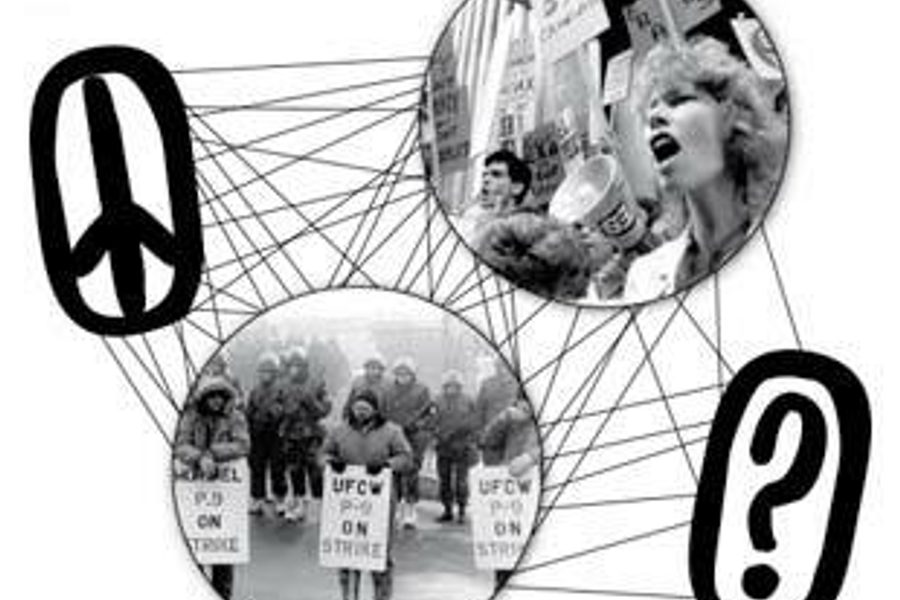The Left’s Identity Crisis
What does it mean to be a progressive in 2007? What do we stand for? What do we believe in?
Ken Brociner

“Love me, love me, I’m a liberal” was one of the most memorable protest songs of the ’60s. Written, recorded and performed by the late, great Phil Ochs, the song expressed the widespread anger that ’60s radicals felt toward mainstream liberalism during that tumultuous era.
Today, in the eyes of many progressive activists, a similar divide exists within the Democratic Party. According to this view, the Democrats’ intra-party struggle either pits the insider vs. outsider, grassroots activists vs. elites or sellouts vs. those willing to fight for what they believe in (or all of the above).
By setting up these misleading dichotomies, too many activists have contributed to the dilution of what was widely meant by the word “progressive” when it became the adjective of choice for the left sometime in the mid-to-late ’70s. The fact is, over the past 10 to 15 years, the label “progressive” has come to be used so loosely that it has lost much of the substance that it had in the ’70s, ’80s and early ’90s.
So what does it mean to be a progressive in 2007? What do we stand for? What do we believe in?
The extraordinary buzz surrounding Matt Bai’s new book, The Argument: Billionaires, Bloggers and the Battle to Remake Democratic Politics, has brought these issues to the surface in a way that almost nothing else has in recent years. Yet, rather than help bring clarity to the debates within the movement, Bai only adds to the confusion.
By any measure, Bai, The New York Times Magazine’s leading political journalist, has written an entertaining narrative that combines serious analysis with an often rollicking mix of humor and political gossip. In doing so, he provides readers with a rare and fascinating inside view into some of the key players in the blogosphere, the leadership of the Democratic Party and the secretive world of the multimillionaires and billionaires who are bankrolling many of the left’s most important organizations.
The author tells us that over the past three years, he “set out across the country to find the places where this nascent [progressive] movement was coalescing and to trace its arc.” He then goes on to explain the significance of the book’s title: “The movement that dominates the next generation of American politics will be the one … that articulates some new and persuasive argument for how we meet the future.”
Bai’s quest to see if anyone or any organization has come up with “the argument” (or as he also characterizes it, “new ideas” and/or “one big idea”), seems to be based on a silver-bullet theory of social change. As such, many readers will find Bai’s near-obsessive search for “the argument” to be a one-dimensional way of analyzing what is a complex, multilayered process.
He focuses almost exclusively on the newly formed Democracy Alliance (a small group of mega-rich liberals), the netroots, including MoveOn.org, and a handful of Democratic politicians, such as Bill Clinton, Howard Dean, Rep. Rahm Emanuel (Ill.), Rep. Nancy Pelosi (Calif.) and Sen. Charles Schumer (N.Y.). As a result, Bai nearly ignores most of the mass organizations that define so much of the progressive movement.
For example, the AFL-CIO receives scant attention. Same with the National Organization for Women (NOW), the NAACP, the Human Rights Campaign, the Association of Community Organizations for Reform Now (ACORN), USAction, the Sierra Club and a host of other significant groups on the liberal-left.
While Bai can be overly cynical, he does offer some valid criticism of progressives. At the same time, however, he also takes more than a few cheap shots at MoveOn.org, a number of leading bloggers and John Edwards, among others.
Furthermore, for a savvy political writer, Bai exhibits a poor understanding of the historical and contemporary nature of political ideology. He strangely refers to Simon Rosenberg as “an early progressive visionary.” Yet Rosenberg is nothing more than a former Democratic Leadership Council (DLC) staffer, who now heads the New Democrat Network, and who, in the past few years, has moved a few millimeters to the left of dead center. Bai also characterizes former New York Gov. Mario Cuomo as being a voice from “the old left” – a label long used to describe the communist and socialist movements of the ’30s, ’40s and ’50s.
Bai uses the term “progressive” loosely, not only because of his own lack of an ideological framework, it seems, but also because he is reporting on a movement that itself is similarly confused about just who and what is really “progressive.”
Howard Dean, for example, has become one of the progressive movement’s leading heroes. Although he took a more critical stance toward the war in Iraq than did other major Democratic candidates in 2004, he was not any further to the left than John Kerry, John Edwards or Dick Gephardt were on a whole range of issues, including the basic one of economic inequality. So, aren’t we just kidding ourselves when we make Dean out to be a champion of progressive causes?
A similar ideological incoherence can be found among the netroots. In Crashing the Gate, a book co-written by Jerome Armstrong (sometimes known as the “Blogfather” for the pioneering role he played in the early years of the netroots) and Markos Moulitsas, the founder of Daily Kos, the authors vociferously denounce the DLC for being too timid and centrist. Yet at the same time, they suggest that a return to the good old days of the DLC-aligned Clinton administration would be close to political paradise.
More recently, Armstrong became a leading consultant in the short-lived presidential campaign of Mark Warner, the former governor of Virginia, who is widely seen as one of the DLC’s shining stars. While Moulitsas didn’t go as far as endorsing Warner, his public comments about the Virginian made it clear that “Kos” is also a fan.
Activists in the netroots seem to pride themselves on being leaderless. But when two of its most prominent figures display such inconsistency (or hypocrisy, take your pick), this can only further weaken the general understanding of what it means to be progressive for the countless new activists in the movement.
Over the next year, as we mobilize for the election, this kind of confusion probably won’t matter much. Operating under the Big Tent organizational model may be the most effective way to remain united for the showdown on Nov. 4, 2008.
But if the Democrats recapture the presidency, we will need to create a much more visible, left-oriented wing of the progressive movement than exists today. A government of the center-left – which is all we can reasonably hope for, no matter who is elected president – simply won’t be capable of bringing about the kinds of fundamental changes that are so desperately needed here at home as well as throughout the rest of the world.
What’s more, with a Democrat in the White House, a watered-down progressive movement would run the real risk of becoming complacent or co-opted. Regardless of the results on Election Day, we will need to sharpen our understanding of what kind of progressive movement is required in the years ahead.

I hope you found this article important. Before you leave, I want to ask you to consider supporting our work with a donation. In These Times needs readers like you to help sustain our mission. We don’t depend on—or want—corporate advertising or deep-pocketed billionaires to fund our journalism. We’re supported by you, the reader, so we can focus on covering the issues that matter most to the progressive movement without fear or compromise.
Our work isn’t hidden behind a paywall because of people like you who support our journalism. We want to keep it that way. If you value the work we do and the movements we cover, please consider donating to In These Times.





